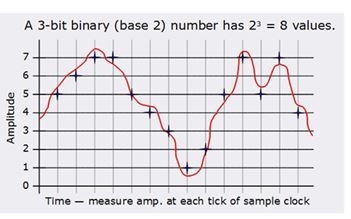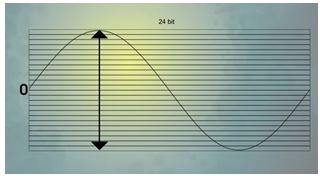
Engineering AcademyContinuing Education Series |
The Alphabet Soup of Digital Audio Terms
In our first installment we took a look at the differences in analog and digital audio levels and metering. We thought this was a worthwhile starting point since this is an area that we see and use most often. When we continue to look “under the hood” at digital we find that it resembles a “bowl of alphabet soup”. There are hundreds of acronyms that will cause engineers to have that “deer in the headlight” stare when confronted with the various terms. This month we will share some information concerning one of the items in our “soup”.
The ability of the ADC (analog to digital converter) to faithful create a digital representation of the original analog waveform is based primary on two items, the sample rate (how often the waveform is sampled) and the bit depth (number of bits in the digital word)
 The goal is each time the waveform is sampled a digital word is created which represents the “level” of the waveform. If you use a 3 bit word the level at each point can hold values from 0 to 8. This is found by raising 2 to the 3rd power.
The goal is each time the waveform is sampled a digital word is created which represents the “level” of the waveform. If you use a 3 bit word the level at each point can hold values from 0 to 8. This is found by raising 2 to the 3rd power.
A 4-bit word would be able to represent 16 different levels. This increases the accuracy of each sample as it compares to the original analog waveform.

It is easy to understand that the more bits used in a digital word the more accurate the description of the level is going to be. The CD standard is to sample the waveform 44,100 times a second and use a digital word made up of 16 bits. Following the examples above using a 16 bit sample would allow the value to be anything between 0 and 65,236. Moving upward a 24 bit sample creates 16,777,216 levels of resolution.
Using the thought that one should always start with the best resolution possible, most in house production is done with the higher bit depth…24 bit or even 32 bit. This is fine until you have to “down convert” to 16 bit to create a CD or transmit over the air.
As one reduces the bit-depth, such as from a 24bit-resolution sample to a 16bit-resolution sample, you are reducing the number of values available to measure the amplitude of any given sample.
In other words you now have fewer values available to describe the dynamic range of your audio.

This “truncation” (another word in our soup) results in the loss of very low signal levels, and the creation of audible distortion where the values have been rounded, squaring off the waveform.
The problem results from something Nyquist didn’t mention about a real-world implementation-the shortcoming of using a fixed number of bits (16, for instance) to accurately represent our sample points. The technical term for this is “finite wordlength effects”.
Welcome to Dither….
Dither is low volume noise, introduced into digital audio when converting from a higher bit-resolution to a lower bit-resolution. The process of reducing bit-resolution causes quantization errors, also known as truncation distortion, which if not prevented, can sound very unpleasant. Introducing this subtle noise to an audio file prior to reducing the bit-depth eliminates the truncation distortion. You are in effect trading the distortion for noise.
To help better understand dithering, use the hand over your computer monitor analogy. How it works is you start by holding your hand over your computer monitor.
Notice that you can see your computer monitor perfectly with the exception of the block where your hand is. Now, if you wave your hand rapidly back and forth from left to right across the screen (applying dither), it allows you to see the entire screen as opposed to blocks of the screen.
If you try and play a 24bit audio file through one of these 16bit playback devices, it will sound awful. In this regard, you should keep the consistency of bit-depth throughout your production process from beginning to end. If you are producing in 24bit and your playback is set to 16bit, then you should be using a dithering tool in your production chain.
If you are recording and producing in 16bit, and your playback is in 16bit, then there is no need to dither.
In the next article we will cover other items found in our “alphabet soup”.
We welcome comments and suggestions about this article plus other technical areas of interest that you would like to have covered. Previous issues of this series can be found here.
Merry Christmas and a Happy New Year from the ABA Engineering Academy

Larry Wilkins CPBE®
ABA Engineering Academy Director
Alabama Broadcasters Association
334-303-2525